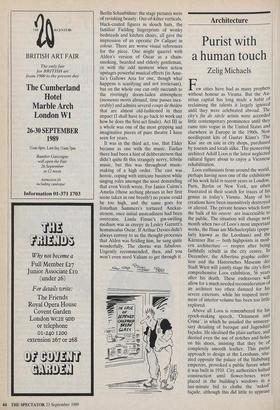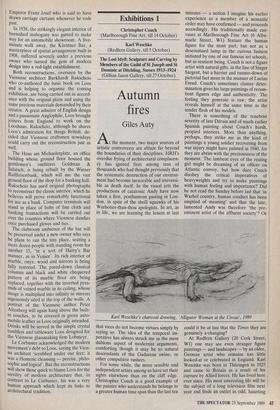Architecture
Purist with a human touch
Zelig Michaels
Few cities have had as many prophets without honour as Vienna. But the Au- strian capital has long made a habit of reclaiming the talents it largely ignored until they were celebrated abroad. The city's fin de siècle artists were accorded little contemporary prominence until they came into vogue in the United States and elsewhere in Europe in the 1960s. Now needlepoint kits of Gustav Klimt's 'The Kiss' are on sale in city shops, purchased by tourists and locals alike. The pioneering architect Adolf Loos is the latest neglected cultural figure about to enjoy a Viennese rehabilitation.
Loos enthusiasts from around the world, perhaps having seen one of the exhibitions of his work held in recent years in London, Paris, Berlin or New York, are often frustrated in their search for traces of his genius in today's Vienna. Many of his creations have been insensitively destroyed or altered. The private houses which form the bulk of his oeuvre are inaccessible to the public. The situation will change next month when two of Loos's most important works, the Haus am Michaelerplatz (popu- larly known as the Looshaus) and the Karntner Bar — both highpoints in mod- em architecture — reopen after being faithfully rebuilt in the city centre. In December, the Albertina graphic collec- tion and the Historisches Museum der Stadt Wien will jointly stage the city's first comprehensive Loos exhibition, 56 years after his death. These endeavours will allow for a much needed reconsideration of an architect too often damned for his severe exteriors, while his inspired treat- ment of interior volume has been too little explored.
Above all Loos is remembered for his epoch-making speech, 'Ornament and Crime', in which he assailed the unneces- sary detailing of baroque and Jugendstil façades. He idealised the plain surface, and decried even the use of notches and holes on his shoes, insisting that they be of completely smooth leather. This purist approach to design at the Looshaus, situ- ated opposite the palace of the Habsburg emperors, provoked a public furore when it was built in 1910. City authorities halted construction until flower-boxes were placed in the building's windows in a last-minute bid to clothe the 'naked' façade, although this did little to appease Emperor Franz Josef who is said to have drawn carriage curtains whenever he rode past.
In 1938, the strikingly elegant interior of burnished mahogany was gutted to make way for an automobile showroom. A five- minute walk away, the Karntner Bar, a masterpiece of spatial arrangement built in 1908, suffered severely under a previous owner who turned the gem of modern design into a red-light establishment.
Hoth reconstructions, overseen by the Viennese architect Burkhardt Rukschcio who co-authored the basic book on Loos and is helping to organise the coming exhibition, are being carried out in accord- ance with the original plans and using the same precious materials demanded by their creator. A great admirer of English design and a passionate Anglophile, Loos brought Joiners from England to work on the Looshaus. Rukschcio, although he shares Loos's admiration for things British, de- cided that Viennese craftsmen nowadays could carry out the reconstruction just as well.
The Haus am Michaelerplatz, an office building whose ground floor housed the gentlemen's outfitters Goldman & Salatsch, is being rebuilt by the Wiener Raiffeisen bank, which will use the vast ground floor of the shop for a banking hall. Rukschcio has used original photographs to reconstruct the classic interior, which he believes will prove remarkably functional for use as a bank. Computer terminals will stand in place of bolts of fine cloth and banking transactions will be carried out over the counters where Viennese dandies once purchased gloves and ties. The clubroom ambience of the bar will be preserved under a new owner who says he plans to run the tiny place, seating a mere dozen people with standing room for another 15, 'in a sort of Harry's Bar manner, as in Venice'. Its rich interior of marble, onyx, wood and mirrors is being fully restored. The pared-down classical columns and black and white chequered pattern of its marble floor are being replaced, together with the inverted pyra- mids of veined marble in its ceiling, whose image is multiplied into infinity in mirrors ingeniously sited at the top of the walls. A Portrait of the Viennese author Peter Altenberg will again hang above the built- in couches, to be covered in green auto- mobile leather as Loos originally intended. Drinks will be served in the simple crystal tumblers and tableware Loos designed for the Viennese glassmaking firm Lobmeyr. Le Corbusier acknowledged the modern movement's debt to Loos, saying the Vien- na architect 'scrubbed under our feet; it was a Homeric cleansing — precise, philo- sophic and logical'. But the reconstructions will show those quick to blame Loos for the sterility of modern architecture that, in contrast to Le Corbusier, his was a very human approach which kept its links to architectural tradition.



























































 Previous page
Previous page